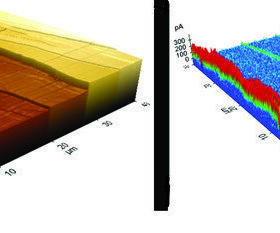
Scientists at Pennsylvania State University have developed a new class of perovskite materials, which they say exhibits unique properties that could have several implications for the development of perovskite solar cells, as well as other electronic applications.
A class of two-dimensional perovskite materials synthesized by a team of scientists at Penn State University has been found to exhibit a unique set of properties, which the team says could open up new pathways for the development of solar cells and other electronic devices based on the technology.
The key finding in their research is that the material is highly conductive at its edges and insulating at its core. “We found a material that has completely different properties along the edges compared to the core,” explained Shashank Priya, professor of materials science and engineering and associate vice president for research at Penn State. “It’s very unusual that the current can flow around the edges and not in the center of a material, and this has huge implications for the design of solar cell architectures.”
The material, described in the paper Distinct conducting layer edge states in two-dimensional (2D) halide perovskite, published in the journal Science Advances, comprises alternately stacked layers of an organic hydrocarbon-based layer and an inorganic lead halide crystal layer. The cell is built in this way so that the organic layer protects the crystals from moisture, which would cause it to degrade. However, in this case, the layered structure was observed to have large variations in conductivity.
According to the researchers, taking advantage of these properties could provide an efficiency boost to solar technology by creating additional pathways for a charge to move through the device. They also theorize that it could open up new possibilities in the field of nanoelectronics and also be a good candidate for use in triboelectric nanogenerators, which turn motion into electricity. “Across the length of these materials, you have a junction between metal and semiconductor, and there are a lot of hypothetical devices proposed based on that junction,” Priya said.
Lắp đặt điện mặt trời Khải Minh Tech
https://ift.tt/2X7bF6x
0906633505
info.khaiminhtech@gmail.com
80/39 Trần Quang Diệu, Phường 14, Quận 3
Lắp đặt điện mặt trời Khải Minh Tech
https://ift.tt/2ZH4TRU
Không có nhận xét nào:
Đăng nhận xét